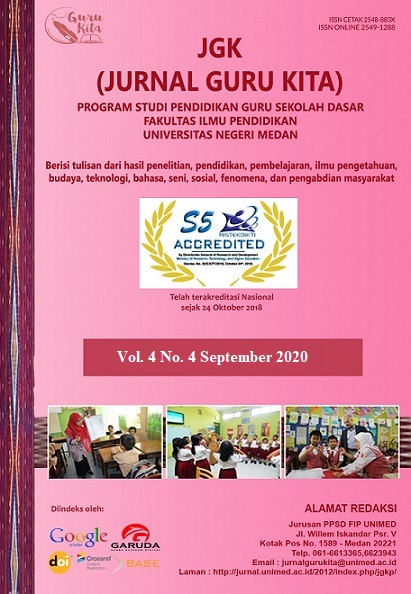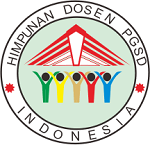PENERAPAN MODEL PEMBELAJARAN REALISTIK UNTUK MENINGKATKAN HASIL BELAJAR IPA MATERI GERAK DAN GAYA KELAS VIII-5 SMP NEGERI 6 MEDAN TAHUN AJARAN 2018/2019
DOI:
https://doi.org/10.24114/jgk.v6i2.42007Keywords:
Realistic Learning, Motion and Style, Science Learning Outcomes.Abstract
Application of a Realistic Learning Model to Improve Science Learning Outcomes Material of Motion and Style for Class Viii-5 SMP Negeri 6 Medan Academic Year 2018/2019. The purpose of carrying out this research is to find out that the application of Realistic Science Learning can improve student learning outcomes in the material of Motion and Style in class VIII-5 of SMP Negeri 6 Medan in the 2018/2019 Academic Year. This study used a type of action research (PTK) consisting of pre-cycle and 3 (three) class cycles. The location of this research was carried out at SMP Negeri 6 Medan. Data collection techniques using student learning outcomes tests and observations made are observations of all activities and changes that occur when the action is given, and data analysis techniques with comparative descriptive analysis. Based on the results of the study, after being given action in cycle I, classical learning completeness was obtained by 25%, while in the second learning achievement test, classical learning mastery was obtained by 68.75% or an increase of 43.75% from cycle I, and on the results test learning III obtained classical learning mastery of 87.50% or an increase of 18.75% from cycle II. So that a realistic science approach to the material of Motion and Style can improve the science learning outcomes of class VIII-5 students of SMP Negeri 6 Medan. It can be concluded that through realistic learning on the material Motion and Style students in class VIII-5 at SMP Negeri 6 Medan feel enthusiastic in learning because the questions given are questions related to everyday life and each student is active and free to determine the solution of each problem according to their respective thoughts. Furthermore, the teacher and students draw conclusions from a formulation of a concept or principle from the problem at hand.References
Abdurrahman dan Soejono, (2005), Metode Penelitian Suatu Pemikiran dan Penerapan, Rineka Cipta, Jakarta
Adrian, W., (2009), IPA Bilingual, Yrama Widya, Bandung.
Arikunto, S., (2008), Penelitian Tindakan Kelas, Bumi Aksara, Jakarta.
Arsyad, A., (1997), Media Pembelajaran, Rajagrafindo Persada, Jakarta.
Asrori, M., (2008, Penelitian Tindakan Kelas, Wacana Prima, Bandung.
Djamarah dan Zain, (1995), Strategi Belajar Mengajar, Rineka Cipta, Jakarta
Djumanta, W., (2008), IPA Untuk Kelas VIII SMP/ Madrasah Tsanawiyah, Grafindo Media Pratama, Jakarta.
Fakultas IPA dan Ilmu Pengetahuan Alam Universitas Negeri Medan, (2010), Buku Pedoman Penulisan Skripsi dan Proposal Penelitian Pendidikan, FMIPA Unimed, Medan.
Hasan, C., (1994), Dimensi-Dimensi Psikologi Pendidikan, Al-Iklas, Surabaya
Hudojo, H., (1990), Strategi Belajar Mengajar IPA, Depdikbud, Malang
Johnson, E., (2010), CTL Contextual Teaching & Learning, Kaifa, Bandung.
Maryono, S., Metode Penelitian Pendidikan, Rineka Cipta, Jakarta.
Rasyid dan Mansur, (2007), Penilaian Hasil Belajar, Wacana Prima, Bandung
Sagala, S., (2005), Administrasi Pendidikan Kontemporer, Alfabeta, Bandung.
Sanjaya, W., (2008), Strategi Pembelajaran Berorientasi Standar Proses Pendidikan, Kencana Prenada Media Group, Jakarta.
Sihombing, W.L., (2006), Telaah Kurikulum IPA Sekolah, FMIPA Unimed, Medan.
Slameto., (2003), Belajar dan Faktor-faktor yang Mempengaruhinya, Rineka Cipta, Salatiga.
Suherman, Erman., (2008), Komunikasi Matematis, http://educare.e-fkipunla.net (diakses Agustus 2011)
Sukidin, Basrowi, dkk., (2008), Manajemen Penelitian Tindakan Kelas, Insan Cendekia, Jakarta.
Sumiati dan Asra., (2007), Metode Pembelajaran, Wacana Prima, Bandung.
Surya, M., (1997), Hakikat dan Pengertian Belajar, http://akhmadsudrajat. wordpress.com/2008/hakikatbelajar (diakses Agustus 2011)
Susilana dan Riyana, (2007), Media Pembelajaran, Wacana Prima, Bandung.
Sinaga, D., (2009), Keefektifan Pembelajaran IPA dengan Pendekatan Kontekstual pada Siswa Kelas VIII SMPN 2 Rantau Selatan Rantau Prapat, Tesis tidak diterbitkan, Medan : Unimed.
Tim dosen UNIMED, (2008), Strategi Belajar Mengajar IPA, FMIPA UNIMED, Medan.
Trianto, (2009), Mendesain Model Pembelajaran Inovatif-Progresif Kencana Prenada Media Group, Jakarta.
Wilson, Sukino, S., (2006), IPA SMP Jilid 2 Untuk Kelas VIII, Erlangga, Jakarta.
Downloads
Published
How to Cite
Issue
Section
License
Authors published with the JGK (Jurnal Guru Kita) agree to the following terms:
- Authors retain copyright and grant the journal the right of first publication with the work simultaneously licensed under a Creative Commons Attribution License (CC BY-SA 4.0) that allows others to share the work with an acknowledgment of the work's authorship and initial publication in this journal.
- Authors are able to enter into separate, additional contractual arrangements for the non-exclusive distribution of the journal's published version of the work (e.g., post it to an institutional repository or publish it in a book), with an acknowledgment of its initial publication in this journal.
- Authors are permitted and encouraged to post their work online (e.g., in institutional repositories or on their website) prior to and during the submission process, as it can lead to productive exchanges, as well as earlier and greater citation of published work. (See The Effect of Open Access)


























